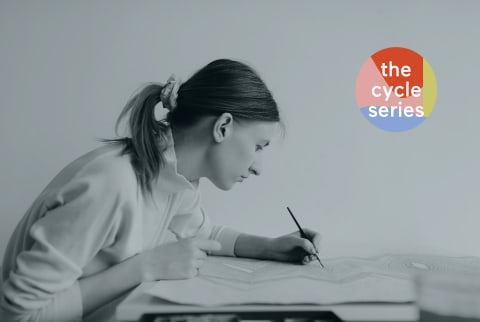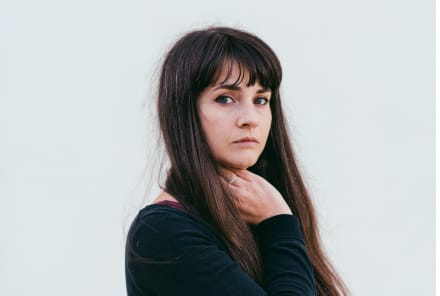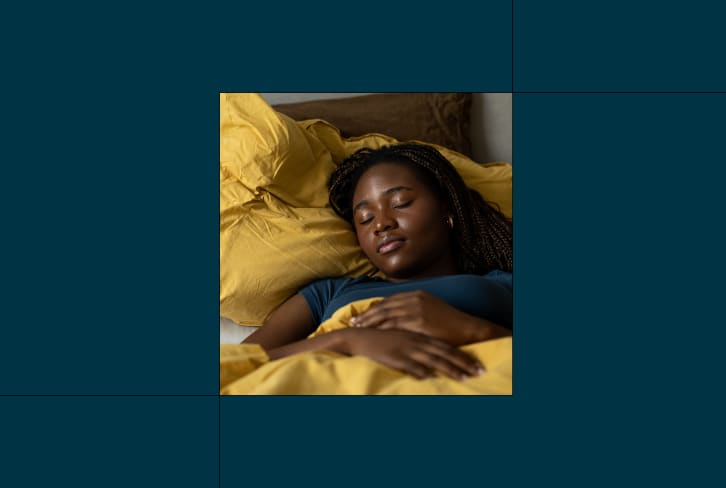Advertisement
How Your Creativity Fluctuates During Your Cycle & The Best Times To Channel It


Whether you spend your 9 to 5 in a creative job or express yourself through hobbies like visual art or music, we all have a creative side. At times, creative inspiration flows effortlessly, akin to a river, while on other occasions, it might seem as if a dam is impeding the flow of your brilliant ideas.
This is true for everyone—it's just the nature of the brain. When you're tired, mentally preoccupied, or stressed, your creative output will likely suffer because of it. Even the most successful songwriters and artists out there need to take a break every now and again.
But it's only natural to wonder: Can we anticipate the times when we'll feel our most creative? And do they line up to cycles like the menstrual cycle? Here's what experts have to say and how to use their insights to your advantage in your creative life.
Editor's note
A closer look at how creativity may vary throughout the cycle
Encyclopaedia Britannica defines creativity as, "The ability to make or otherwise bring into existence something new, whether a new solution to a problem, a new method or device, or a new artistic object or form."
This gets at the idea that, without any glitz or glam, a creative endeavor is, at its core, a task. It just tends to be a more pleasurable one.
Anything that influences your ability to finish a task (from motivation, energy, and mood) will impact how creative you feel as well. So while a certain menstrual phase may not be an on/off button for creativity per se, your hormones do in fact drive some of the factors feeding creative potential. Here's what's at play in each phase:

During your period, you may feel less creative, so just listen to your body
"Fluctuations in estrogen and progesterone throughout the cycle can impact energy levels and motivation," says board-certified OB/GYN and reproductive endocrinologist Anate Brauer, M.D.
Both hormones are depleted during your period, so you may feel less motivated to engage in creative pursuits during this time.
As you can imagine, your motivation will also depend on your menstrual symptoms (some women have breezy periods, others horrible weeklong menses). But either way, your hormones aren't exactly setting you up for a creative awakening during this time. Take any time you need to rest and recharge accordingly.
Also, remember that creativity doesn't always need to look like productivity. Reading an inspiring book, doodling without an end goal, writing for the fun of it, and creating mood boards solely for enjoyment are all creative projects that typically require less motivation. They may be great things to try when you're feeling tired or low energy but still craving that creative spark.
After your period is over, your creative window is wide open, so plan to get some work done
Once your period is over (the follicular phase), estrogen is at its peak and progesterone is rising simultaneously, dialing up your energy and motivation. During this phase, you may also experience better sleep, less anxiety, and more energy for movement and exercise.
Some studies show that movement can spark innovative thinking1, and your follicular phase is ripe for exercise—be it lifting heavier weights, running farther distances, or trying more intense workout classes.
Not everyone has the luxury of syncing up their creative projects to their follicular phase, but if you do have that ability, why not give it a try?
In the second half of the luteal phase, you may have some PMS symptoms, so consider finding inspiration for your next project instead of creating something new
After the follicular phase, we move into the luteal phase. "Toward the end of the luteal phase, just before the next menses, estrogen is at its lowest. This often contributes to feelings of stress, depression, and insomnia," Brauer says. If this is the case and you experience PMS symptoms, it's certainly not the time to try to force yourself to be creative.
In fact, holding yourself to an unrealistic standard while dealing with lack of sleep, mood swings, and anxiety can make you feel even worse.
Instead, focus on what you know makes you feel good. Take a long walk outside, spend more time winding down than you usually do, enjoy a warm bath, etc. The goal during the latter half of the luteal phase is just to get through and treat yourself with compassion.
If you know that you tend to have fairly strong PMS symptoms during this time, consider trying to schedule your creative projects around it. This isn't always possible, but if you can swing it, you may save yourself from a day of frustration trying to squeeze ideas from a tired brain.
Plus, you can spend this time admiring the work of others and finding inspiration in the world around you. By the time you reach your peak energy levels, you'll have a steady base of inspiration to help you create something new.
A functional gyno's POV
What about birth control and menopause?
Women on combination birth control receive a steady dose of hormones throughout the month. Because of this, they may not feel the strong fluctuations of progesterone and estrogen impacting their energy and motivation.
However, those on tri-phasic pills that vary in hormone levels to mimic a natural cycle may resonate more with the traditional fluctuations covered above.
During menopause, women experience a drop in all hormones, including estrogen and progesterone. This doesn't mean that creativity will be at an all-time low by any means, but you may feel more mental and physical fatigue getting in the way of it.
If you're struggling with fatigue in menopause, consult your physician, as there are steps you can take to naturally boost energy and mental sharpness.
How to support your hormones & creativity
So here we are, knowing that hormones directly impact motivation, energy, and thus creativity, but left wondering if the only way to deal is by scheduling in creative projects for the best two weeks of the month (an unrealistic wish for most folks).
But don't worry, there are plenty of ways to get those creative juices flowing in any phase. The key is to minimize the traditional energy and motivation depleters beyond hormones. Here's how:
Movement & nutrition
- Keep yourself fueled & hydrated: There's nothing worse than trying to come up with an idea when you're hungry and dehydrated. Before you give up, try eating a nourishing meal and having a few glasses of water. Chances are, you'll feel a whole lot better.
- Prioritize daily movement: Research has shown that daily movement is beneficial to creativity2, so try to make it a part of your routine. Even if you're feeling tired, a five-minute walk or stretch on your bedroom floor can make a world of difference in your mood and energy.
- Try a creative movement form like dance: Now, if you want to combine your creative skills and get some movement while you're at it, consider booking a dance class like Zumba or ballet. In fact, dance has been shown to be even more effective at treating depression than some medications3, making it a worthwhile workout to try when you're struggling with mood throughout any phase of your cycle.
Lifestyle
- Try meditation to channel your creative energy at any time: If you aren't one to try classic meditation, consider the active route. "It could be a time when you are doing mundane tasks or activities such as taking a hike in the country, doing the housework, or working on a different project," says clinical psychologist and licensed marriage and family therapist Nadia Teymoorian, Ph.D.
- Spend time outside: Research shows that time spent in nature is beneficial for creativity4, so consider taking your movement outside or finding a nice spot to host a brainstorm where you can feel the grass under your feet or wind on your face.
- Plan creative endeavors for the follicular phase: As mentioned above, consider your follicular phase after your period the best time to complete a creative project.
- Have a place to write down your inspirations: Inspiration is everywhere–in nature, in conversation, in writing, and so on. Even if you're not feeling up to creating something new or embarking on a large project, writing down those little nuggets of inspiration can better prepare you for when you do feel up to it.
The takeaway
Creativity is undeniably impacted by motivation and energy, both of which fluctuate with hormones like estrogen and progesterone. After your period and before ovulation is when you'll likely feel the most creative, and the second half of the luteal phase is likely when your creativity will be at its lowest. No matter the phase, it's important to work with your personal rhythms instead of trying to resist the natural ebbs and flows of your body.
Creativity isn't the only thing that might shift with your cycle—here's how your sex drive and athletic ability tend to change throughout the month.
Watch Next
Enjoy some of our favorite clips from classes
Enjoy some of our favorite clips from classes
What Is Meditation?
Mindfulness/Spirituality | Light Watkins
Box Breathing
Mindfulness/Spirituality | Gwen Dittmar
What Breathwork Can Address
Mindfulness/Spirituality | Gwen Dittmar
The 8 Limbs of Yoga - What is Asana?
Yoga | Caley Alyssa
Two Standing Postures to Open Up Tight Hips
Yoga | Caley Alyssa
How Plants Can Optimize Athletic Performance
Nutrition | Rich Roll
What to Eat Before a Workout
Nutrition | Rich Roll
How Ayurveda Helps Us Navigate Modern Life
Nutrition | Sahara Rose
Messages About Love & Relationships
Love & Relationships | Esther Perel
Love Languages
Love & Relationships | Esther Perel

















